Archive:Enlargement countries - education statistics
- Data from September 2013. Most recent data: Further Eurostat information, Main tables and Database.
This article is part of an online publication based on the ‘Key figures on the enlargement countries – 2014 edition’ pocketbook and presents population-related information and statistics on the education systems in the enlargement countries and in the European Union (EU). It gives an overview of the demographic development, covering the most important indicators, i.e. crude birth rate, crude death rate and fertility. It also offers information on major trends at different educational levels in terms of enrolment, educational attainment and tertiary education.
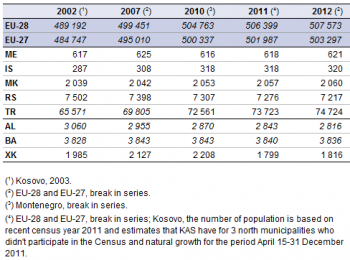
Source: for the EU aggregates, Eurostat (demo_pjan); for the enlargement countries, Eurostat (cpc_psdemo)

Source: for the EU aggregates, Eurostat (demo_pjangroup); for the enlargement countries, Eurostat (cpc_psdemo)

Source: for the EU aggregates, Eurostat (demo_gind); for the enlargement countries, Eurostat (cpc_psdemo)
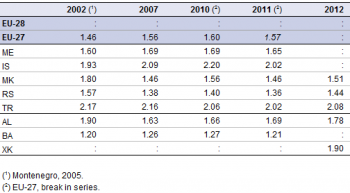
Source: for the EU aggregates, Eurostat (demo_find); for the enlargement countries, Eurostat (cpc_psdemo)
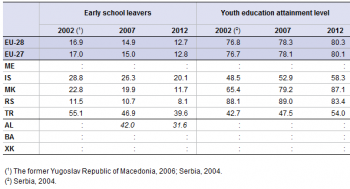
Source: for the EU aggregates, Eurostat (edat_lfse_14) and (edat_lfse_08)); for the enlargement countries, Eurostat (cpc_psilc) and (cpc_siinr)
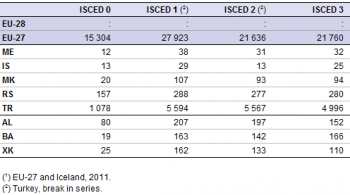
Source: for the EU aggregates, Eurostat (educ_ilev); for the enlargement countries, Eurostat (cpc_pseduc)

Source: for the EU-27, Eurostat (educ_ilev); for the enlargement countries, Eurostat (cpc_pseduc)
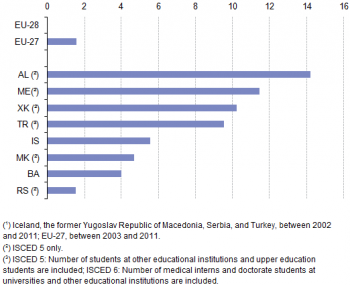
Source: for the EU-27, Eurostat (educ_enrl1tl); for the enlargement countries, Eurostat (cpc_pseduc)
Main statistical findings
Population
Different trends of population over time
In 2012, more than 500 million persons lived in the European Union. That same year, the combined population of the enlargement countries represented nearly a fifth of the total EU population (see Table 1). Turkey was by far the largest among them, with more than 74 million inhabitants (corresponding to 15 % of the European Union), whereas Iceland and Montenegro were the smallest, with populations of 320 thousand and 621 thousand respectively (figures for 2012).
Over time, the demographic evolution in the enlargement countries was quite diverse: while the population in Turkey and Iceland increased by nearly 14 % and 11.5 % when comparing 2002 and 2012, that of Kosovo[1] (-8.5 %), Albania (-7 %) and Serbia (-3.8 %) decreased significantly when comparing the same years (or 2003 and 2012 for Kosovo). The other three enlargement countries saw their numbers of inhabitants remain relatively stable during this decade.
A younger population in Turkey and Albania
In the EU-28, the working age population (persons aged 15-64) accounted for just over two-thirds of the total population while the youngest population (persons aged under 15) accounted for 15.6 % and the oldest (persons aged over 64) represented nearly 18 % of the total population (see Figure 2). In the enlargement countries, the population is generally younger than in the EU: the under 15s represented a share of between 17.2 % (the former Yugoslav Republic of Macedonia) and 28.0 % (Kosovo) in 2012, whereas the over 65s accounted for only 6.7 % (Kosovo) and 15.1 % (Bosnia and Herzegovina). Serbia was the exception among the enlargement countries, with the population age structure very similar to that of the EU. Kosovo and Turkey clearly have the youngest populations among the enlargement countries, which puts considerable pressure on the national educational systems and the labour market.
Crude birth rates higher than crude death rates in most enlargement countries
A crude rate of natural increase is calculated by subtracting the crude death rate from the crude birth rate, with a positive result showing that the size of the population is growing, disregarding the effects of migration. In recent years, Serbia and Bosnia and Herzegovina were the only countries to experience crude death rates markedly higher than crude birth rates (see Table 3). Moreover, this discrepancy rose with time, indicating a faster population decline. Hence, the crude rate of natural decrease in this case (rather than increase) was 4.9 per thousand inhabitants in Serbia in 2012. In contrast, the largest crude rate of natural increase was recorded in Turkey, with a value of 12 per thousand inhabitants, closely followed by Kosovo with 11.3 per thousand inhabitants in 2012.
Fertility rates of over 2 children per woman in Iceland and Turkey
Only two of the enlargement countries, Turkey and Iceland, recorded fertility rates of over 2 children per woman in the latest years for which data are available. In Turkey, the rate actually fell between 2010 and 2011, but in 2012 it rose again to 2.1 children per women, making for the highest rate among the enlargement countries. The rates were more volatile in most of the other enlargement countries. At a lower level in absolute terms, the EU recorded a declining tendency in the fertility rate according to the latest available data.
Education
Serbia recorded low percentages of early school leavers and high youth education attainment level
Education and training policies are central to the Europe 2020 strategy in order to turn the EU into a smart, sustainable and inclusive economy. One of the flagship initiatives of Europe 2020 is ‘Youth on the move’ which aims to enhance the performance of education systems and to facilitate the entry of young people into the labour market. In particular, one of the headline targets of Europe 2020 is to reduce the share of early school leavers to less than 10 % of the population aged 18–24.
Between 2002 and 2012, the proportion of early school leavers fell both in the EU and in the enlargement countries for which data are available. The decrease amounted to 4.2 percentage points in the EU, to reach 12.7 %. For the enlargement countries, the decrease ranged between 3.4 and 11.1 percentage points between 2002 and 2012 (or over the period for which data are available), with the exception of Turkey, where the decrease was substantially higher, with 15.5 percentage points. Compared to the 12.7 % of early school leavers in the EU in 2012, Serbia reported a comparatively low level (8.1 %). In contrast, the proportion of early school leavers in both Albania and Turkey was 31.6 % and 39.6 % respectively, according to the latest available data. The share of the EU population aged 20 to 24 that reached at least an education level of ISCED 3 (upper secondary education) had been steadily rising and was close to 80 % in 2012. Similar trends can be observed in the enlargement countries for which data are available, with the exception of Serbia which recorded consecutive decrease of the youth educational attainment level from 2009 onwards. Nevertheless, the youth education attainment level in Serbia (83.4 %) was higher than that of the EU-28 average.
Tertiary education in permanent development during the last decade
In 2012, there were 108 million pupils and students (from pre-primary to tertiary education) in the EU-28. In the enlargement countries, it is estimated that around 25 million pupils and students were enrolled in the same year (see Table 6). Obviously, the number of pupils depends on various factors, such as the size and structure of the population, the characteristics of the educational system (e.g. the length of compulsory schooling) and the opportunities on the labour market. Between 2002 and 2012, the number of students attending tertiary education increased in the EU as well as in the enlargement countries for which data are available. Almost all of the enlargement countries recorded higher growth rates than those of the EU. The average annual growth in Albania, Montenegro and Kosovo appeared particularly strong and increased by 14.2 %, 11.5 % and 10.2 %, respectively (refers to ISCED 5 only). In Turkey and Iceland, the average growth rate was between 5 % and 10 %, while in the former Yugoslav Republic of Macedonia, Bosnia and Herzegovina and Serbia the rate did not exceed 5 %.
Data sources and availability
Data for a core set of indicators are collected each year through questionnaires sent out by Eurostat to the partner countries. A network of contacts in each country has been established for updating the questionnaires. Eurostat distributes the electronic questionnaires to a single contact point in each partner country. This contact point is in charge of the onward distribution of the questionnaires to the various thematic co-ordinators in each country's statistical system (generally within the national Statistical Offices) and of their collection afterwards. When completed, the validated and updated questionnaires are sent back to Eurostat.
Context
Eurostat collects statistical information on the demographic conditions and education in enlargement countries. These data allow a better understanding of the situation in these countries and allow comparisons with the European Union. These data are also used when the European Commission prepares its annual strategy document detailing its policy on EU enlargement and the progress reports on the political and economic developments in enlargement countries.
See also
- Enlargement countries - statistical overview - online publication
- International statistical cooperation - online publication
- Population and population change statistics
- Population projections
- Population structure and ageing
- Sustainable development - demographic changes
Further Eurostat information
Publications
- Key figures on the enlargement countries – 2014 edition
- Enlargement countries - Population and social conditions - 2013 edition
- Key figures on the enlargement countries – 2013 edition
- Pocketbook on the enlargement countries - 2012 edition
Database
- Population and social conditions (cpc_ps)
- Candidate countries and potential candidates: population - demography (cpc_psdemo)
- Candidate countries and potential candidates: education (cpc_pseduc)
- Population (populat), see:
- Demography (pop)
- Demography - National data (demo)
- Population (demo_pop)
- Demography - National data (demo)
- Education (educ)
- Education indicators - non-finance (educ_indic)
- Distribution of pupils/ Students by level (educ_ilev)
- Education indicators - non-finance (educ_indic)
Dedicated section
Methodology / Metadata
External links
Notes
- ↑ This designation is without prejudice to positions on status, and is in line with UNSCR 1244 and the ICJ Opinion on the Kosovo Declaration of Independence.